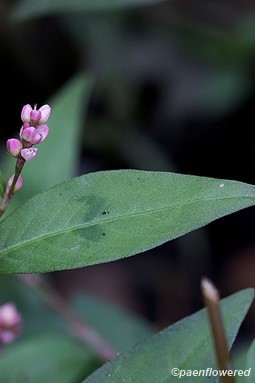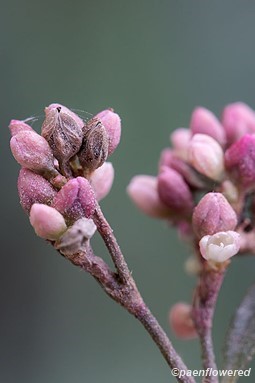Persicaria maculosa
Most common of all smartweeds, this plant has a 'thumb-print' on its leaves
Persicaria maculosa lady's-thumb
Add to MyPlants View Locations
This member of the buckwheat family is native to Eurasia but has been introduced and spread widely in North America. It has become a common weed throughout the state. It is very similar in many ways to the other smartweeds in that they have a tight spike-like cluster of tiny pink or whitish flowers and knotted stems with a papery sheath at each joint.
Lady’s thumb can be an erect or sprawling plant with narrow leaves, often with a dark green, brown, purple or reddish triangular blotch that is said to resemble a lady’s thumb print. My observations seem to show that the "thumb print" may be green on young leaves, but as the leaves begin to turn age and turn red, the "thumb print" may be the first area to show a reddening. These leaves can be 2 to 6 inches long.
Individual flowers are only 1/8 inch long, but the flower cluster can be up to 2 inches long. The fruit is seed-like, glossy black and 3-sided. The stems are reddish giving the species the alternate common names of redleg and redshank. The sheaths at the stem nodes all have hair-like fringes.
The plant can grow 8-30 inches long and is found in cultivated ground, damp clearings and waste places. It blooms from June to October.
Habitat & Range
Common in disturbed, moist, and open spaces such as fields, roadsides, forest margins, ditches.
Present throughout the state.
| EMP: | FACW |
|---|---|
| NCNE: | FAC |
Phenology
Flowers June to October.
Persicaria maculosa lady's-thumb
Synonyms: Polygonum persicariaAdd to MyPlants View Locations













.JPG?v=638217088360000000)

.jpg?v=638921765700000000)

Comments
Have you spotted this plant in your area? We'd love to hear about your experience! Share your comments or questions about the plant below. Comments are moderated before posting.